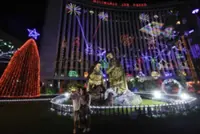PETALING JAYA: Malaysia’s travel industry is seeking to attract more Chinese Muslim tourists as the country gears up for Visit Malaysia Year 2026 with the target of becoming an umrah destination in the region.
Recent trends reveal a significant uptick in arrivals from this demographic, which will be among Malaysia’s emerging new markets.
The Islamic Tourism Centre of Malaysia (ITC) has found a marked increase in Muslim tourists from China with 26,534 arrivals last year and is anticipating 40,172 of them for the first quarter of 2024.
“Efforts by the Tourism, Arts and Culture Ministry such as promotional activities, visa easing and enhanced air connectivity specifically tailored to the Chinese market are credited with invigorating tourism flow,” said ITC director-general Nizran Noordin.
“With the widespread availability of halal food, mosques and surau in public spaces, Malaysia presents itself as an incredibly inclusive and welcoming destination for Muslim travellers.”
ITC’s role is to assist the ministry through strategic tourism research and market intelligence as well as provide training and capacity-building services in relation to Islamic tourism.
“The ITC’s Muslim-Friendly Tourism and Hospitality Assurance and Recognition (MFAR) programme plays a pivotal role in cementing Malaysia’s position as a preferred Muslim tourist destination,” said Nizran when contacted.
The programme has specific guidelines to help tourism industry players position themselves strategically in the Muslim tourism market. This, he said, would ensure that the travellers are provided with services that align with Islamic practices.
The MFAR guidelines are currently available for two schemes – tourist accommodation premises and travel operating businesses.“ITC will soon develop guidelines for eight others, namely spa and wellness centres, medical facilities, transportation hubs, tourism products, shopping malls, theme and entertainment parks, Rest and Relax areas (R&R) and trade and convention centres,” he said.
Nizran added that ITC aims to enrol more industry players in the MFAR programme to enhance the tourism ecosystem and called for input from government bodies and travel agencies to meet specific market needs.
“Tourists often allocate a big portion of their budget for shopping, creating ample opportunities for businesses to meet the demand of Muslim travellers for consumer goods. These include Muslimah fashion and active wear, cosmetics, personal care products and halal pharmaceuticals,” he said.
Nizran also said Muslim travellers, particularly the younger demographic, have a keen interest in local culture.
“This presents an opportunity for tourism players to develop tailored itineraries that emphasise local experiences such as cooking classes showcasing regional cuisine, tours of herb gardens and other interactive activities,” he said.
There was positive feedback from a China imam familiarisation trip recently, highlighting Malaysia’s hospitality and ability to cater to Muslims’ needs.
“China remains a strategic market with its 30 million-strong Muslim population. The Malaysian Inbound Chinese Association (Mica) has teamed up with ITC to develop tourism packages suited for Muslim visitors,” added Nizran.ITC, he said, would also enhance the capabilities of 211 tourist guides through specialised training so that they become Muslim-Friendly Tourist Guides.
Nizran also touched on the 50th anniversary of China-Malaysia diplomatic relations this year.
“The timing is right to move into this market. The market in China is huge and ITC would like to encourage more tourism industry players to look into the potential and opportunities,” he added.
Malaysia has maintained a top spot in the Global Muslim Travel Index since its inception in 2015.
Separately, Mica president Datuk Dr Angie Ng said Chinese Muslim tourists have a deep appreciation for Malaysia’s Muslim culture, food, shopping and the Ramadan experience.
She said they come to Malaysia to experience a different Muslim dietary culture including over 200 types of kuih-muih offered at hotel Ramadan buffets.
“In Negri Sembilan, they were surprised with a sheep head dish, which offers a completely different flavour.
“One tourist shared that during his week-long stay, he visited different hotels to try various halal dishes daily,” Ng said, adding that Chinese Muslim tourists are captivated by the stunning architecture of the mosques here.“They also adore our beaches and are fond of buying colourful traditional Malay attire as gifts for family and friends,” she added.
Malaysian Association of Hotels president Datin Christina Toh said the hotel industry would continuously enhance its facilities to meet the growing demand of Muslim tourists as the market flourishes.
“Part of our star-rating hotel requirement includes at least one halal-certified outlet and the presence of Qibla signs,” she said, adding that some hotels can convert meeting rooms into prayer rooms while others provide shuttle services to nearby mosques.
Toh also said Chinese tourists, including free independent travellers, are increasing due to visa-free entry and improved accessibility.
To break the language barrier, she said with advancements in AI and mobile technology, information can be translated easily to assist travellers.
“Malaysia’s reputation as a Muslim-friendly destination is well established,” she added.







